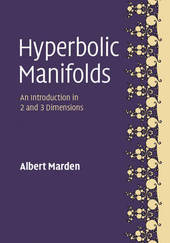
|
Hyperbolic Manifolds: An Introduction in 2 and 3 Dimensions
Hardback
Main Details
| Title |
Hyperbolic Manifolds: An Introduction in 2 and 3 Dimensions
|
| Authors and Contributors |
By (author) Albert Marden
|
| Physical Properties |
| Format:Hardback | | Pages:529 | | Dimensions(mm): Height 255,Width 181 |
|
| Category/Genre | Algebra
Geometry |
|---|
| ISBN/Barcode |
9781107116740
|
| Classifications | Dewey:514.34 |
|---|
| Audience | | Professional & Vocational | |
|---|
| Illustrations |
Worked examples or Exercises; 15 Halftones, unspecified; 21 Halftones, color; 40 Line drawings, unspecified
|
|
Publishing Details |
| Publisher |
Cambridge University Press
|
| Imprint |
Cambridge University Press
|
| Publication Date |
1 February 2016 |
| Publication Country |
United Kingdom
|
Description
Over the past three decades there has been a total revolution in the classic branch of mathematics called 3-dimensional topology, namely the discovery that most solid 3-dimensional shapes are hyperbolic 3-manifolds. This book introduces and explains hyperbolic geometry and hyperbolic 3- and 2-dimensional manifolds in the first two chapters and then goes on to develop the subject. The author discusses the profound discoveries of the astonishing features of these 3-manifolds, helping the reader to understand them without going into long, detailed formal proofs. The book is heavily illustrated with pictures, mostly in color, that help explain the manifold properties described in the text. Each chapter ends with a set of exercises and explorations that both challenge the reader to prove assertions made in the text, and suggest further topics to explore that bring additional insight. There is an extensive index and bibliography.
Author Biography
Albert Marden is a Professor of Mathematics at the University of Minnesota.
Reviews'The diagrams, over 60 in number and for the most part highly intricate computer-generated graphics, will leave the reader craving for more.' Tushar Das, MAA Reviews 'With its plenitude of exercises, both closed- and open-ended, and its extensive index and bibliography, this book merits what a reviewer wrote of the first edition: its 'topic's central importance and the author's singular viewpoint earn this book a place in all academic libraries.' Summing Up: Recommended. Upper-division undergraduates and above; faculty and professionals.' F. E. J. Linton, CHOICE '... the book provides an excellent overview of the developments of recent decades in the theory of hyperbolic 3-manifolds.' Thilo Kuessner, Mathematical Reviews
|